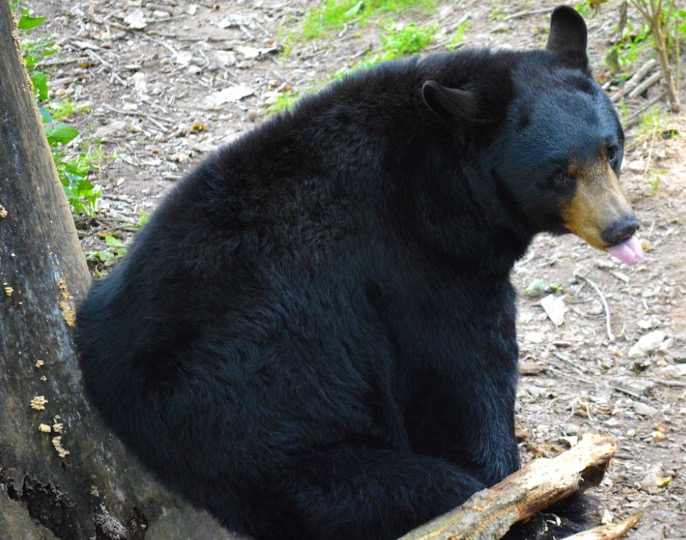Table of Contents
American Black Bear: What You Need To Know
The American black bear is a small generalist omnivore that belongs to the kingdom of Animalia, phylum Chordata, and class Mammalia. Its genus is Ursus, and its species is Ursus americanus. Its length is 1.2 to 2.0 m, and it weighs about 39 to 409 kg. It lives in the dense forests and woodlands with a lifespan up to 18 years.
The American black bear is a big North American animal belonging to the Ursidae family. It is a medium-sized bear that may be found across Canada, the United States, and portions of Mexico, making it the world’s most common bear species.

American Black Bear Description
Although black is the most common colour, there are a variety of different colour morphs and subspecies, including white and cinnamon. Their muzzles are usually pale, and some have a tiny patch of white chest fur. Males are approximately 4.5-6.5 ft (1.4-2.0 m) long from head to tail, while females are normally 4-6 ft (1.4-2.0 m) long (1.2-1.6 m). Black bears range in size from 85 to 900 pounds, depending on the location and season (39-409 kg).

Their jaws are strong and their heads are wide. They have sharp teeth in their jaws, including canines that are several inches long. Their slender, rounded claws are black or gray-brown on their big paws. Black bears have round, erect ears and short vestigial tails. Their fur is velvety and is made up of a thick underfur and longer, coarse guard hairs.

American Black Bear Habitat and Distribution
The American black bear’s range is extensive, extending over Canada and Alaska, as well as various portions of the United States and even north-central Mexico. Its range was formerly much larger, but it has since been diminished and divided by human settlement and development. Black bears generally dwell in wooded regions within this range.
Among the dense foliage of the forest subcanopy, the ideal black bear habitat is quite inaccessible. People continue to encroach on the natural habitat of this and many other species as human civilization increases over much of their historic range.
As a result, the American black bear has earned a reputation for being one of the most common bears seen in human-populated regions, lured mostly by ill-managed food and other attractants. They may be found from sea level to up to 10,000 feet (3000 metres) in mountainous locations, and they have a generalist diet.

American Black Bear Diet and Predators
Black bears are omnivores, meaning they eat a wide range of foods. Their meals vary greatly according to the season and home range, but berries, roots, eggs, small animals, and birds, as well as juvenile ungulates, are all frequent. Larger animals that have already died are also known to be scavenged by American black bears.
They have excellent vision and hearing, as well as a keen sense of smell. If fish are accessible in their environment, black bears are good swimmers and will frequently enter the water to pursue them. They feed at night most of the time, although this is dependent on the presence or absence of other predators such as brown bears and people.
American Black Bear Reproduction
Female black bears (sows) attain sexual maturity between the ages of three and five. The breeding season lasts around 2-3 months and occurs in the spring and early summer. Both sexes are promiscuous, which means they will mate with more than one partner during the breeding season. The fertilised egg suffers delayed development after copulation, and embryos are not formed until November of the same year.
Their 235-day gestation cycle begins at this time, with 1-6 cubs ultimately born in January or early February. The cubs will open their eyes and begin walking after around 5 weeks. They are weaned at around 30 weeks and become independent at around 16-18 months, venturing off to find their own territory and partners.
Male bears will generally move further away, whereas female bears will frequently take up a territory near to or overlapping with their mother’s area. In the wild, American black bears have an average lifespan of around 18 years, but some individuals have been known to live longer.
Fun Facts About American Black Bear!
Due to their flexibility and generalist approach, black bears are the most numerous bears on the planet. This also makes them one of the most often seen bears and the most probable bear species to be involved in a negative human encounter.
A Fed Bear is a Dead Bear
Interactions between people and animals are becoming more common as humans continue to intrude on natural areas across the world. Black bears are known for being drawn to the scent of trash and other human waste. They frequently congregate in dumps.
They do, however, have strong instincts that drive their actions, such as defending a food supply, as do other wild animals. When scavenging for food waste such as garbage, a bear may be in an area where it does not belong, but it does not always realise it. Many bears that have learned to rely on rubbish as a food source may become violent in their defence of it.
Because this is such a dangerous situation, conservation officers or game wardens frequently euthanize these bears. As a result, if you care about bears and want to protect them, it is your obligation to ensure that there are no attractants in your area. Most bears will not stick around if they are not being fed, and so situations like bear euthanasia may be easily avoided with a little foresight and effort.
Despite the fact that certain populations are endangered, the species is the world’s most abundant bear and is classified as “Least Concern” on the IUCN Red List of endangered species. Except for the brown bear, which is very numerous, all other bear species are considered endangered.
Black is the New Brown
Grizzly bears, sometimes known as brown bears, and black bears, while sharing a historical distribution in North America, are not closely related, having separated 5.05 million years ago. The Asian black bear (Ursus thibetanus), commonly known as the moon bear because of its distinctive crescent-shaped white patch of fur on its breast, is more closely related to the American black bear (Ursus thibetanus).
Surprisingly, the Asian black bear has adapted to an arboreal existence, spending much of its time in the trees. Although the American black bear is capable of climbing trees, it prefers to utilise them as a safe haven from predators rather than as a regular home. As black bears become older and bigger, this is especially true.
Brown bears, on the other hand, are often too big to climb trees effectively. Despite their geographical separation and differing habits, the two black species share certain characteristics. Helarctos malayanus, or the sun-bear, is another Asian species with a crescent-shaped patch of fur on its breast that has recently split from Ursus thibetanus and Ursus americanus.
Until the latest glacial period, 10,00 years ago, there were likely more similar species in North America. After that, until the brown bear arrived on the continent across the land bridge between Eurasia and North America at the time, the American black bear was the only bear species on the continent.
The Spirit Bear
Black bears aren’t all the same colour. Some subspecies come in a variety of hues, including dark brown and fawn. The existence of a tiny population of U. americanus in a remote region of coastal British Columbia, Canada, is perhaps most intriguing. About 10% of the individuals of this subspecies, known as Kermode or the Spirit Bear (Ursus americanus kermodei), have a white or light colour morph. The remaining 90% of the population appears to be ordinary black bears.
The Canadian Black Bear
Much of the historic range of the American Black Bear has been wiped out. The species’ current distribution includes much of the west and east coasts of the United States, as well as some scattered populations in the Rocky Mountains and Sierra Nevadas, as well as northern Mexico. The majority of bears, on the other hand, may be found in Canada, where their distribution is still relatively unbroken.
American Black Bear Citations
- Bearing fruit: Piloting a novel judgment bias task in an American black bear. Zoo Biol . 2021 Mar;40(2):89-97.
- Retinal cone photoreceptor distribution in the American black bear (Ursus americanus). Anat Rec (Hoboken) . 2021 Mar;304(3):662-672.
- Behavior in Free-Living American Black Bear Dens: Parturition, Maternal Care, and Cub Behavior. Animals (Basel) . 2020 Jul 1;10(7):1123.







